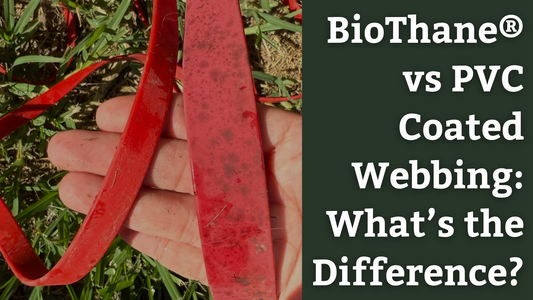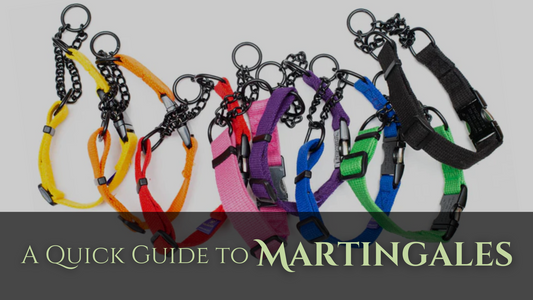We know this sounds like the start of a really boring engineering manual or something, but we promise it’s not too complicated and it’s more important than you may have thought! Until we went into the business, we freely admit that we didn’t spend a single braincell pondering the importance of leash hardware and its structural integrity. So, now that we have, please allow us to give you the breakdown.
Dog gear is only ever as strong as its weakest point. The weak point of any leash (or collar) is almost always going to be what we call the point of connection; that is where it connects to you – the handle, or where it connects to the dog – the hardware.
Essentially, the point of connection is the hardware; whether that’s the stitching in the material, or the metal bits attached to the leash, i.e. the snap, the D ring, as well as any rivets or screws holding it together. So, whether your leash is made out of top notch BioThane®, or the cheapest PVC webbing around; it’s a moot point if the point of connection is not strong enough to withstand the right amount of force (which is higher than you’d think).

Breaking Loads and Safe Working Loads
Now, before we dip our toes very lightly into some physics, we’d like to offer a disclaimer to stress that we are not engineers or physicists. We are but humble dog enthusiasts who have delved into the wonderful world of hardware safety and want to pass this valuable knowledge on to you. We’re gonna keep it as straightforward as possible. Okay? Let’s go.
There are two numbers that are most important when it comes to your hardware’s durability. To make it confusing straight off the bat, these numbers are often referred to in different ways. Most often they are called the minimum breaking load (MBL) or the safe working load (SWL). You might also see these numbers referred to as the working load limit or rated capacity, but ultimately they all amount to the same thing.
The breaking load is the minimum point at which the hardware will fail. As an example, let’s say it’s 200kg. This number is determined by factors such as the material that it’s made of (e.g. die cast zinc, stainless steel, or brass) and the style of snap (usually swivel bolt snaps).
It’s important to note that stitching can also fail, but we have a whole other type of calculation for determining the strength of stitching components. It’s dependent on the type of thread, the tensioning and the stitch pattern (usually either box stitch or bar tack).

The safe working load is the point at which the hardware is recommended for safest use. This number is determined by taking the MBL and dividing it by a number called the safety factor (usually 5, but can be up to 10 if we’re being conservative). Using our example of 200kg, this means that we calculate our safe working load as follows:
If our MBL is 200kg, and we divide by the safety factor of 5, that gives us a SWL of 40kg. However, here’s the rub:
We could easily say, Great! This leash is therefore suitable for a 40kg dog. Except that a 40kg dog is capable of exerting far more than 40kg of force when running or lunging. So, to factor that in, we’d rate equipment like this as being only suitable for much smaller dogs, perhaps up to 15-20kg, to be safe. This shouldn’t come as a surprise to anyone who’s owned a small dog with a big ego!
Risky Business
Why does all of this matter? Safety, of course! It matters that we ensure your leash doesn’t break at an inopportune time, like your dog trying to run across a busy road, or lunge for another dog.
Any time the hardware is under stress (that is, when it’s being pushed past the safe working load, and into breaking load territory), it’s at greater risk of failure.
Much like how it’s advised to replace your child’s car seat after an accident, even if no damage is visible; your leash hardware is taking invisible damage every time it’s being used past the safe working load. And this isn’t even taking into account additional factors such as water and sun damage, which will degrade hardware durability even faster.
Ultimately, as with all essential safety items like car seats, seat belts and helmets; they are a precaution that will not need to come into effect... until they absolutely do. For the most part, as any dog owner knows, dogs don’t have the greatest sense of self-preservation. This means we must rely on tools and training to keep them safe. Part of that is ensuring the tools are rated correctly to handle our dogs. That’s why we believe working loads and breaking loads are a crucial point of safety in all leashes and collars.

How Can You Be Sure?
Many manufacturers should be able to tell you the SWL and the MBL for their products if you ask! Be sure to consider the materials being used as well. Cheap gear is cheap for a reason, but cheap doesn’t necessarily mean bad. It just means they use cheaper materials which haven’t undergone break testing (a pricy process). But cheap gear definitely has its place as a great light-use, low-cost option until you’re able to invest in something better.
For durable and weather-proof options, look for stainless steel and brass hardware as the stronger choices. If you’re looking for light-weight options for older or smaller dogs; then nickel or zinc-alloy can be a great choice.
In summary, not all leashes are created equal! And that doesn’t mean it’s about buying the fanciest, most expensive thing around, far from it. It’s about understanding what’s appropriate and safe for you and your dog, and armed with that knowledge, the ability to purchase safe gear within your means. As always, we highly recommend evaluating the best options for you and your dog before making a decision. Happy walkies!




